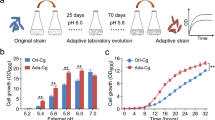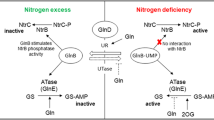Abstract
The PhoPR two-component system, a highly conserved system in corynebacteria and mycobacteria, is involved in the cellular response to environmental stress. When analysing the transcriptomic data of Corynebacterium glutamicum strains under different dissolved oxygen (DO) levels, PhoPR was found to be the most responsive two-component system to DO changes. Here, we systematically investigated the expression of PhoPR in response to different DO levels and its impact on genes related to global regulation and energy metabolism. Using Green fluorescent protein as a reporter, we confirmed that PhoPR was significantly upregulated upon decrease of DO. Through real-time quantitative PCR and electrophoretic mobility shift assay, we found that the effector protein PhoP directly activated glxR (encoding a global regulator), pfk and gapA (encoding the glycolytic enzymes) and ctaD (encoding cytochrome c in the electron transport chain), while downregulated aceE and gltA (encoding the TCA cycle enzymes). Overexpression of phoP or phoR resulted in a decreased intracellular NAD+/NADH ratio and increased intracellular ATP level, consistent with the gene expression changes regulated by PhoP. These results reveal the PhoPR system respond to oxygen deficiency and is responsible for the regulation of pathways involved in the sustainability of the energy levels required under low oxygen conditions. Our findings in this study not only provide new insights into the adaptation pathways of C. glutamicum in response to low oxygen conditions but also identify new possible genetic targets for the construction of the new cell factories aimed toward industrial applications.






Similar content being viewed by others
References
Bansal R, Anil Kumar V, Sevalkar RR, Singh PR, Sarkar D (2017) Mycobacterium tuberculosis virulence-regulator PhoP interacts with alternative sigma factor SigE during acid-stress response. Mol Microbiol 104:400–411. https://doi.org/10.1111/mmi.13635
Becker J, Rohles CM, Wittmann C (2018) Metabolically engineered Corynebacterium glutamicum for bio-based production of chemicals, fuels, materials, and healthcare products. Metab Eng 50:122–141. https://doi.org/10.1016/j.ymben.2018.07.008
Cao G, Howard ST, Zhang P, Wang X, Chen XL, Samten B, Pang X (2015) EspR, a regulator of the ESX-1 secretion system in Mycobacterium tuberculosis, is directly regulated by the two-component systems MprAB and PhoPR. Microbiology 161:477–489. https://doi.org/10.1099/mic.0.000023
Deste M, Alvaradomorales M, Angelidaki I (2017) Amino acids production focusing on fermentation technologies—a review. Biotechnol Adv 36:14–25
Gießelmann G et al (2019) Metabolic engineering of Corynebacterium glutamicum for high-level ectoine production: design, combinatorial assembly, and implementation of a transcriptionally balanced heterologous ectoine pathway. Biotechnol J 14:1800417
Gupta V, Jain K, Garg R, Malik A, Gulati P, Bhatnagar R (2018) Characterization of a two component system, Bas1213-1214, important for oxidative stress in Bacillus anthracis. J Cell Biochem 119:5761–5774. https://doi.org/10.1002/jcb.26751
Hammarlund EU, Flashman E, Mohlin S, Licausi F (2020) Oxygen-sensing mechanisms across eukaryotic kingdoms and their roles in complex multicellularity. Science. https://doi.org/10.1126/science.aba3512
Inui M, Suda M, Okino S, Nonaka H, Puskas LG, Vertes AA, Yukawa H (2007) Transcriptional profiling of Corynebacterium glutamicum metabolism during organic acid production under oxygen deprivation conditions. Microbiology 153:2491–2504
Ivan M et al (2001) HIFα targeted for VHL-mediated destruction by proline hydroxylation: implications for O2 sensing. Science 292:464–468
Jaakkola P et al (2001) Targeting of HIF-α to the von Hippel-Lindau ubiquitylation complex by O2-regulated prolyl hydroxylation. Science 292:468–472
Jacob-Dubuisson F, Mechaly A, Betton JM, Antoine R (2018) Structural insights into the signalling mechanisms of two-component systems. Nat Rev Microbiol 16:585–593. https://doi.org/10.1038/s41579-018-0055-7
Jervis AJ et al (2009) The O2 sensitivity of the transcription factor FNR is controlled by Ser24 modulating the kinetics of [4Fe–4S] to [2Fe–2S] conversion. Proc Nat Acad Sci 106:4659–4664
Jungwirth B et al (2013) High-resolution detection of DNA binding sites of the global transcriptional regulator GlxR in Corynebacterium glutamicum. Microbiology 159:12–22. https://doi.org/10.1099/mic.0.062059-0
Kaboré AK, Delaunay S, Blanchard F, Guedon E, Fick M, Olmos E (2019) Study and modeling of fluctuating dissolved oxygen concentration impact on Corynebacterium glutamicum growth in a scale-down bioreactor. Process Biochem 77:8–17
LeBlanc JG, Chain F, Martín R, Bermúdez-Humarán LG, Courau S, Langella P (2017) Beneficial effects on host energy metabolism of short-chain fatty acids and vitamins produced by commensal and probiotic bacteria. Microb Cell Fact 16:1–10
Maxwell PH et al (1999) The tumour suppressor protein VHL targets hypoxia-inducible factors for oxygen-dependent proteolysis. Nature 399:271–275
Niebisch A, Bott M (2001) Molecular analysis of the cytochrome bc1-aa3 branch of the Corynebacterium glutamicum respiratory chain containing an unusual diheme cytochrome c1. Arch Microbiol 175:282–294. https://doi.org/10.1007/s002030100262
Okino S, Inui M, Yukawa H (2005) Production of organic acids by Corynebacterium glutamicum under oxygen deprivation. Appl Microbiol Biotechnol 68:475–480
Park SH, Kim HU, Kim TY, Park JS, Kim SS, Lee SY (2014) Metabolic engineering of Corynebacterium glutamicum for L-arginine production. Nat Commun 5:4618. https://doi.org/10.1038/ncomms5618
Peng F, Liu X, Wang X, Chen J, Liu M, Yang Y, Bai Z (2019) Triple deletion of clpC, porB, and mepA enhances production of small ubiquitin-like modifier-N-terminal pro-brain natriuretic peptide in Corynebacterium glutamicum. J Ind Microbiol Biotechnol 46:67–79
Pérez-García F, Jorge JM, Dreyszas A, Risse JM, Wendisch VF (2018) Efficient production of the dicarboxylic acid glutarate by Corynebacterium glutamicum via a novel synthetic pathway. Front Microbiol 9:2589
Pontinen A, Lindstrom M, Skurnik M, Korkeala H (2017) Screening of the two-component-system histidine kinases of Listeria monocytogenes EGD-e. LiaS is needed for growth under heat, acid, alkali, osmotic, ethanol and oxidative stresses. Food Microbiol 65:36–43. https://doi.org/10.1016/j.fm.2017.01.018
Prunty MP, Noone D, Devine KM (2018) The distinct PhoPR mediated responses to phosphate limitation in Bacillus subtilis subspecies subtilis and spizizenii stem from differences in wall teichoic acid composition and metabolism. Mol Microbiol. https://doi.org/10.1111/mmi.13965
Ravcheev DA et al (2012) Transcriptional regulation of central carbon and energy metabolism in bacteria by redox-responsive repressor Rex. J Bacteriol 194:1145–1157
Salazar ME, Laub MT (2015) Temporal and evolutionary dynamics of two-component signaling pathways. Curr Opin Microbiol 24:7–14. https://doi.org/10.1016/j.mib.2014.12.003
Schreuder LJ, Carroll P, Muwanguzi-Karugaba J, Kokoczka R, Brown AC, Parish T (2015) Mycobacterium tuberculosis H37Rv has a single nucleotide polymorphism in PhoR which affects cell wall hydrophobicity and gene expression. Microbiology 161:765–773. https://doi.org/10.1099/mic.0.000036
Semenza GL, Nejfelt MK, Chi SM, Antonarakis SE (1991) Hypoxia-inducible nuclear factors bind to an enhancer element located 3’to the human erythropoietin gene. Proc Nat Acad Sci 88:5680–5684
Sun Y, Guo W, Wang F, Zhan C, Yang Y, Liu X, Bai Z (2017) Transcriptome analysis of Corynebacterium glutamicum in the process of recombinant protein expression in bioreactors. PLoS One 12:e0174824. https://doi.org/10.1371/journal.pone.0174824
Taabazuing CY, Hangasky JA, Knapp MJ (2014) Oxygen sensing strategies in mammals and bacteria. J Inorg Biochem 133:63–72
Tanaka A, Nakamura H, Shiro Y, Fujii H (2006) Roles of the heme distal residues of FixL in O2 sensing: a single convergent structure of the heme moiety is relevant to the downregulation of kinase activity. Biochemistry 45:2515–2523
Tang G, Wang S, Lu D, Huang L, Li N, Luo L (2017) Two-component regulatory system ActS/ActR is required for Sinorhizobium meliloti adaptation to oxidative stress. Microbiol Res 198:1–7. https://doi.org/10.1016/j.micres.2017.01.005
Toyoda K, Inui M (2016) Regulons of global transcription factors in Corynebacterium glutamicum. Appl Microbiol Biotechnol 100:45–60. https://doi.org/10.1007/s00253-015-7074-3
Tsuge Y, Uematsu K, Yamamoto S, Suda M, Yukawa H, Inui M (2015) Glucose consumption rate critically depends on redox state in Corynebacterium glutamicum under oxygen deprivation. Appl Microbiol Biotechnol 99:5573–5582
Tuyishime P et al (2018) Engineering Corynebacterium glutamicum for methanol-dependent growth and glutamate production. Metab Eng 49:220–231. https://doi.org/10.1016/j.ymben.2018.07.011
Wang X et al (2018) Identification and validation of appropriate reference genes for qRT-PCR analysis in Corynebacterium glutamicum. FEMS Microbiol Lett 365:fny030
Wang GL, Jiang B-H, Rue EA, Semenza GL (1995) Hypoxia-inducible factor 1 is a basic-helix-loop-helix-PAS heterodimer regulated by cellular O2 tension. Proc Nat Acad Sci 92:5510–5514
Wendisch VF (2014) Microbial production of amino acids and derived chemicals: synthetic biology approaches to strain development. Curr Opin Biotechnol 30:51–58. https://doi.org/10.1016/j.copbio.2014.05.004
Yang Y, Wang F, Sun Y, Liu X, Bai Z (2016) Effect of different dissolved oxygen concentrations on metabolism in Corynebacterium glutamicum. Microbiol China 43:2540–2549
Zheng H et al (2017) Inhibitors of Mycobacterium tuberculosis DosRST signaling and persistence. Nat Chem Biol 13:218–225. https://doi.org/10.1038/nchembio.2259
Zhou X, Zhang N, Xia L, Li Q, Shao J, Shen Q, Zhang R (2018) ResDE two-component regulatory system mediates oxygen limitation-induced biofilm formation by Bacillus amyloliquefaciens SQR9. Appl Environ Microbiol 84:e02744–e02717
Acknowledgements
This work was supported by National Natural Science Foundation of China (Grant Nos. 21808082, 21878124, 22078128 and 21938004); The 111 Project (No. 111-2-06); National frst-class discipline program of Light Industry Technology and Engineering (LITE2018-24). We thank Dr. Giacomo Giacomelli and Abigail Savietto Scholz for their helpful advices on this paper.
Author information
Authors and Affiliations
Contributions
FP, XL, JC and ZB conceived and designed research. FP and JC performed the experiment and analyzed the results. YL, CL and YY contributed new methods. FP, JC, YL and XL wrote and revised the paper. All authors read and approved the final manuscript.
Corresponding author
Ethics declarations
Conflict of interest
The authors declare that they have no conflict of interest.
Ethical approval
This manuscript does not contain any studies with human participants or animals performed by any of the authors.
Additional information
Publisher’s Note
Springer Nature remains neutral with regard to jurisdictional claims in published maps and institutional affiliations.
Supplementary Information
Below is the link to the electronic supplementary material.
Rights and permissions
About this article
Cite this article
Peng, F., Chen, J., Liu, X. et al. The PhoPR two-component system responds to oxygen deficiency and regulates the pathways for energy supply in Corynebacterium glutamicum. World J Microbiol Biotechnol 37, 160 (2021). https://doi.org/10.1007/s11274-021-03131-1
Received:
Accepted:
Published:
DOI: https://doi.org/10.1007/s11274-021-03131-1




